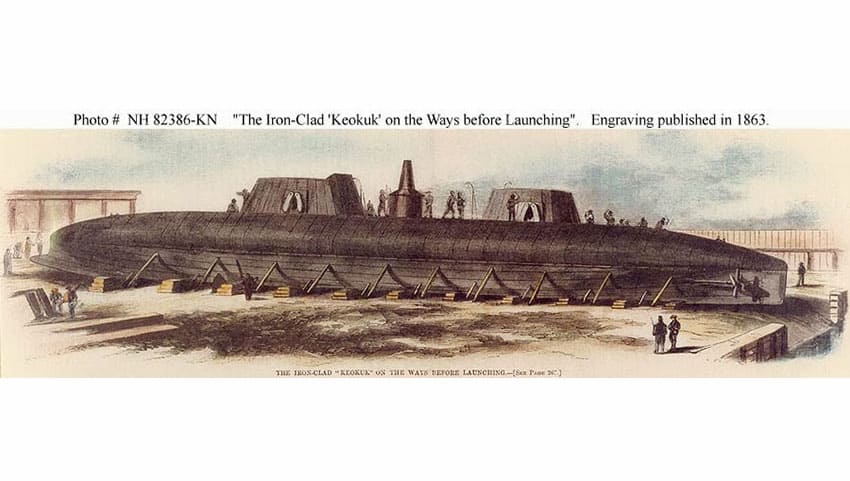
Hand-tinted copy of a line engraving published in Harper’s Weekly, 1863, depicting USS Keokuk at the J.S. Underhill shipyard, New York City, around the time of her December 6, 1862 launching. Courtesy of the US Navy Art Collection, Washington, DC. US Naval Historical Center Photograph. Click on photograph for larger image.
April 5, 1863 – April 18, 1863
By Phil Kohn
Phil Kohn can be reached at USCW160@yahoo.com
Several Confederate ships are detained at Liverpool, England, on April 5, 1863. Although the vessels are ultimately released, their seizure is a signal that the Confederacy can expect less support from the British government going forward. In Virginia, at Falmouth, near Fredericksburg, President Lincoln meets with Maj. Gen. Joseph Hooker and the generals of the Army of the Potomac to discuss strategy. In Chicago, Illinois, reports circulate that between 1,400 and 1,700 Confederate prisoners have died at Camp Douglas, south of the city. The prisoner-of-war camp, established in February 1862, is poorly laid out, lacking sufficient water supplies, drainage and medical facilities. Prisoners are exposed to cold, wet weather with insufficient shelter and blankets. Those who died are victims, primarily, of smallpox, typhoid fever and pneumonia.
Following his discussions with the command staff of the Army of the Potomac, President Lincoln on April 6 sends a memorandum noting: “… our prime objective is the enemies’ [sic] army in front of us, and is not with, or about, Richmond.”
On April 7, nine U.S. Navy ironclads commanded by Flag Officer Samuel Du Pont sail from Hilton Head, South Carolina, to attack Ft. Sumter and other Confederate positions in Charleston Harbor. They are repelled without much damage being done, except to the Federal vessels – six of the nine are heavily damaged by Confederate artillery, one of which, USS Keokuk, sinks the next day. In Tennessee, Confederate Maj. Gen. Joseph Wheeler launches four days of cavalry raids against several railroads, especially the lines connecting Union-held Nashville and the cities of Louisville and Chattanooga.
As ordered by Maj. Gen. U.S. Grant, Union troops under Maj. Gen. John McClernand are positioned at New Carthage, Mississippi, south of Vicksburg on April 8. Carrying supplies and preparing roads for Grant’s upcoming operations against Vicksburg, the Federals begin experiencing sharp resistance from Confederate troops in the vicinity.
From Richmond, Virginia, President Davis, aware that the Southern economy is nearly at the breaking point, on April 9 exhorts Confederate citizens to concentrate agricultural efforts less on the cash crops of tobacco and cotton, and more on subsistence crops such as “corn, oats, peas, potatoes and other food for man and beast.” Earlier, the Richmond Dispatch newspaper had published a report that over the first two years of the war, the cost of feeding a family increased from $6.65 to $68.25 per week.
There is Confederate cavalry action in Tennessee on April 10: Troopers under Maj. Gen. Joe Wheeler attack the Louisville & Nashville Railroad near Hendersonville and wreck a train at Antioch, while a force under Maj. Gen. Earl Van Dorn raids Franklin.
On April 11, Lt. Gen. James Longstreet, detached with two of his divisions from the First Corps of Lee’s Army of Northern Virginia, begins a siege of Union-held Suffolk, Virginia. (Suffolk is adjacent to Norfolk, Virginia, about 150 miles southeast of Fredericksburg.) On the same day, U.S. Army Col. Abel Streight and 1,700 cavalrymen depart from Nashville, Tennessee, traveling by boat down the Tennessee River. The plan is to land in northwestern Alabama and ride some 160 miles far behind Confederate lines, attacking Rome, Georgia. There, they intend to destroy a cannon foundry as well as the machine shops of the Western & Atlantic Railroad, which links Atlanta and Chattanooga.
In Indian Territory, on April 12, a Federal force of about 3,000, including Unionist Cherokees and the 6th Kansas Cavalry, overcomes Confederate Cherokee cavalry and retakes Ft. Gibson, in the Cherokee Nation. In Virginia, Maj. Gen. Joseph Hooker sends a letter to President Lincoln stating that he plans to take the Army of the Potomac across the Rappahannock River and outflank Robert E. Lee and his Confederates, who are still at Fredericksburg. On the same day, in Louisiana, some 15,000 Federal soldiers under Maj. Gen. Nathaniel Banks begin a campaign along Bayou Teche against around 5,000 Confederates under Gen. Richard Taylor. The Union troops win battles at Irish Bend (April 13), Ft. Bisland (April 14) and Ft. Burton (April 19).
Maj. Gen. Ambrose Burnside, now commanding the Department of the Ohio, issues a proclamation on April 13 that Southern sympathizers will be deported to Confederate lines, and anyone convicted of aiding the Southern cause will incur the death penalty.
CSS Alabama, under Capt. Raphael Semmes, on April 15 seizes two U.S.-flagged whaling vessels in the South Atlantic, about 220 miles off the Brazilian coast. In North Carolina, Confederate Maj. Gen. Daniel Hill calls off his siege of Union-held Washington, North Carolina, as a large Federal relief force approaches. As the Southerners withdraw, Federal forces prepare to take the offensive.
On April 16, 11 of 12 U.S. Navy vessels under Acting Rear Admiral David D. Porter successfully run down the Mississippi River past Vicksburg’s batteries. They deliver supplies to a Union depot on the west bank at Hard Times, Louisiana, as part of a build-up to Grant’s assault on Vicksburg, Mississippi.
Col. Benjamin Grierson on April 17 leads 1,700 Federal cavalry southward from LaGrange, Tennessee, on a 16-day, 600-mile raid through Mississippi to divert attention from the buildup of Federal forces near Vicksburg. Along the way, they wreak havoc on two railroads, ruining 50 miles of track and cutting telegraph wires, destroying over 3,000 stands of arms, and capturing 1,000 horses and mules. The raid ends in Baton Rouge, Louisiana, on May 2. From Arkansas, Brig. Gen. John Marmaduke, attempting to draw Union forces northward from Vicksburg, leads a 16-day Confederate cavalry raid into Missouri, harassing Union positions throughout the southeastern portion of the state.
On April 18, Federal troops seize and destroy a Confederate salt works at New Iberia, Louisiana, about 55 miles southwest of Baton Rouge.







